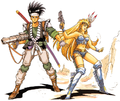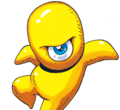Welcome to the SaGa Wiki! We have moved off Fandom very recently, so things are still being set up around here. Please note that some images did not successfully transfer, and will need to be manually reuploaded or replaced.
Note: Keep in mind that once you have an account, you must wait one day and make 5 edits to become autoconfirmed. This allows you to skip questions while editing, to create new articles, and to upload images.
SaGa 2: Hihou Densetsu
| SaGa 2: Hihou Densetsu | |
|---|---|
| {{{image}}} | |
|
| |
| Developer(s): |
{{{developer}}} |
| Publisher(s): |
{{{publisher}}} |
| Artist(s): |
{{{artist}}} |
| Composer(s): |
{{{composer}}} |
| Platform(s): |
{{{platform}}} |
| Release date: |
Game Boy JP December 14, 1990 NA November 1991 NA July 1998 (re-release) |
| Genre: |
{{{genre}}} |
| Modes: |
{{{modes}}} |
SaGa 2: Hihou Densetsu (Sa・Ga2: 秘宝伝説, lit. Sa・Ga2 ~ The Treasure Legend), originaly released in the North America as Final Fantasy Legend II, is a game released for the Game Boy as the second game of the SaGa series. It's the sequel to Makai Toushi SaGa.
A remake for the Nintendo DS, titled SaGa 2: Hihou Densetsu Goddess of Destiny was released exclusively in Japan in 2009.
Synopsis
Story
- "...MAGI... The symbol of great power. The legacy of the ancient gods who made this world.
Many fought for the mighty power. Some won and some failed. Now.... another legend of bravery is about to begin...."
- —Intro
The game begins one late night while the player character sleeps, they are awoken by their father, an explorer and archeologist, who tasks them with protecting an artifact called the Prism while they are gone on their journey. Years later, the player character has grown of age, and their father has yet to return home. Asking their mother if it is alright to leave on a journey to find them, she relents, but asks them to pay a visit to their instructor Mr. S. He informs the player that the Prism artifact is in fact one of the 77 pieces of MAGI which has caused much conflict in the worlds due to greedy people hoping to use their powers to obtain godhood. Now wondering why their father has such a piece, the player character, along with three close friends from school, embark on a journey to find both the player character's dad, and stop the evil forces from collecting the MAGI.
A great tower is located in the world and connects various other worlds together. All these worlds contain MAGI, fragments of an ancient Goddess who existed several eons ago. The party sets out to gather the MAGI to prevent those with sinister methods from collecting it and becoming new Gods.
Characters
While the main party consists of generic characters the player creates, during several points of the story a fifth character will join the party to help out. This includes:
- Dad - The hero's father, he helps out twice on their adventure and is the founder of the Guardians, the people who have sworn to protect the MAGI.
- Hana - A detective. Her father, also a detective, was killed while investigating smugglers. She is looked after by the turtle Kame and has feelings for Taro, a schoolteacher.
- Isis - The Goddess that is summoned by bringing all the MAGI together, Isis helps the party defeat Apollo who has used the power of the MAGI to gain God-like powers.
- Ki - A beautiful cleric, she maintains the Shrine of Isis. She was born with MAGI, enabling her to heal others.
- Lynn - Living in Apollo's world, she goes out on her own to find a cure for her sick mother and joins the party in Dunatis' Cave.
- Mask - A mysterious member of the Guardians who was imprisoned by Ashura, the party rescues him and he joins them in thanks. It is revealed to later be Lynn's dad.
- Mr. S - The main character's teacher, Mr. S is a yellow slime monster who helps guide the party through their first cave.
- Taro - Another member of the guardians, Taro came to Edo to become a school teacher before joining the party.
There are other characters who appear during the course of the story:
- Apollo - A God in his home world, he sends the party out to find the MAGI, but his intents are far more sinister than first realized.
- Venus - A Goddess who only values beautiful things and expels anyone in her world who is not beautiful in her eyes.
- Ashura - A six-armed monster who lives in a tower in his own world where he has imprisoned Mask. He also has a base in the first world where his minions cause trouble for the Guardians.
- Odin - A God who watches over fallen heroes in his palace, Valhalla. If the party dies, they are sent to Odin where he revives them. Later on, he challenges the party to battle, though his intentions are noble. He is perhaps the only "God" in the game who is not greedy and power-hungry.
Gameplay
At the beginning of the game, the player creates their party using a guild system similar to The Final Fantasy Legend. They are given a choice of four races, three of which are from the original Legend:
- Humans - Humans do not learn any abilities, but their stats increase randomly after battles depending on equipment used. They have the most equipment slots and are able to take potions to increase their stats.
- Espers (called Mutants in the English version) - Like Humans, Mutants get random stat increases after a battle. They also may learn or forget a skill, with up to a total of four skills being available to learn.
- Monsters - Monsters get stronger by defeating other monsters. After an enemy is defeated in battle they may drop some meat which the monster can eat, turning them into a new monster thus increasing their stats and possibly teaching them new skills.
- Robots - Robot's stats are dependent entirely on their equipment. Any weapon used by a robot only has half the durability but when a robot rests at an inn their weapon's durability is fully restored. Their weapons will also not break when all of their durability points are used.
Additional guest characters will also assist the party at certain points and unlike the main party these characters have actual names and back stories.
Battle is a standard affair, taken in turns. When the attack option is chosen, the character must decide which weapon they want to attack with. However, equipment has durability. Using a weapon will decrease its durability by one and when it reaches zero it breaks and must be replaced. Luckily a character can equip multiple weapons so they will not be totally useless should one of their weapons break. Every weapon has limited use regardless of whether their attack, agility, or mana-based. Even shields have durability.
Spellbooks can also be bought. While expensive, they are usually stronger than a mutant or monster's version of the spell. Monster and Mutant abilities also have limited uses, but are restored at the Inn. New to the game are the MAGI pieces which can be equipped to boost stats or work as weapons and items battle. Each party member can only equip one at a time.
Development
After the smash success of the original SaGa title for the Gameboy, Square tasked Akitoshi Kawazu and Hiromichi Tanaka to begin working on a sequel. They set out to make a larger game and to better hone some of the ideas they used in the previous game such as the unique leveling system for Espers and Monsters. Nobuo Uematsu returned to work on the score and was accompanied by Kenji Ito who made his debut within the series. The game sold incredibly well in Japan at the time and received good reviews in the West as well.
Like the previous game, SaGa 2 was released in West re-titled as Final Fantasy Legend II to connect it to the first entry. In 1998, Sunsoft American Corp got the rights to republish this entry along with its peers for the Game Boy Color.
In January 2009, Square-Enix made a 3D remake of the game for the DS in honor of the 20th Anniversary of the series.
Packaging artwork
Gallery
Trivia
- The US cover for Final Fantasy Legend II is identical to the Game Boy cover for Final Fantasy Adventure and the SNES cover for Final Fantasy IV (Released in the US under the name Final Fantasy II).
- The Nintendo DS remake of Final Fantasy Legend II was number 14 in gamesTM's Top 20 Most Demanded Video Games to be released in the UK, along with fellow Square-Enix game Blood of Bahamut for the Game Boy Advance.
- This was the first SaGa game composed by long time series composer Kenji Ito.






